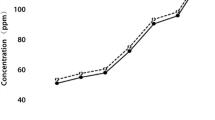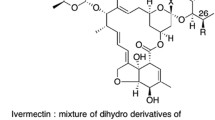Abstract
The molluscicidal activity of Thuricide used as bacterial insecticide,Bacillus thuringiensis, againstBiomphalaria alexandrina andBulunus truncatus was tested.
The obtained results indicate that Thuricide possess a mollus-cicidal activity against both snails species.B. truncatus was more sensitive to the action of Thuricide. However the slope function of the LC50 forB. alexandrina was significantly higher than that forB. truncatus. The mortality rate of exposedB. alexandrina increased by increasing the exposure time.
Exposure ofB. alexandrina to low concentration of Thuricide caused a significant decrease in both ovipository activity and size of egg masses and reduced the percentage of egg hatchability.
Zusammenfassung
Es wurde die molluscizide Wirkung von Thuricide (Bac. thuringiensis) gegen die SchneckenBiomphalaris alexandrina undBulunus truncatus getestet. Die Ergebnisse zeigen, daß Thuricide für beide Schnecken molluscizid war.B. truncatus erwies sich als empfindlicher, doch war die Neigungs-Funktion des LC50-Wertes fürB. alexandrina signifikant höher als fürB. truncatus. Die Mortalitätsrate vonB. alexandrina erhöhte sich mit zunehmender Expositionszeit. Die Exposition vonB. alexandrina gegenüber geringen Konzentrationen von Thuricide verursachte eine signifikante Verringerung sowohl der Eiablage-Aktivität als auch der Größe der Eigelege sowie des Schlüpfprozents der Eier.
Similar content being viewed by others
References
Abou-Bakr, H. E.;El-Husseni, M. M.;Tawfik, M. F. S., 1985: Studies on the entomopathogenic bacteriumBacillus thuringiensis isolated from larvae of the American bollowrmHelliothis armigera (HBN) in Egypt. Bull. Ent. Soc. Egyptian. Econ. Ser.14, 23–28.
Abu-El-Ghar, M. R.;Mohamed, A. M., 1976: Studies on the effect of some pesticides on the snails intermediate hosts of Schistosomiasis in Egypt. Egypt. J. B. Ih. L i 249–254.
Armstrong, J. L.;Rohrman, G. F.;Beaudreau, G. S., 1985: Delta endotoxin ofBacillus thuringiensis subsp.israelensis. J. Bacteriol.161, 39–46.
Davidson, E. W.;Yamamoto, T., 1985: Isolation and assay of the toxin component from the crystals ofBacillus thuringiensis var.israelensis. Curr. Microbiol.11, 171–174.
Dias, E.;Dawood, M. M., 1955: Preliminary trials on the biological snail control withBacillus pinottii in Egypt. Mem. Inst. Oswaldo Cruz53, 13–29.
Fast, P. G., 1971: Isolation of a water soluble toxin from a commerical microbial insecticide based onBacillus thuringiensis. J. Invertebr. Pathol.17, 301.
Geraerts, W. M. P., 1978: Endocrine control of Reproduction ofLimnaea stangalis, Ph. D. Theses. Amsterdam University, Holland.
Harrison, A. D.;Ndukin, W.;Hooper, A. S., 1966: The effects of high magnesium to calcium ratio, on the egg-laying rate of an aquatic snailsBiomphalaria pfeifferi. Ann. Trop. Med. Paras.60, 212–214.
Ignoffo, G. M.;Couch, T. L.;Garcia, C.;Kroha, M. J., 1981: Relative activity ofBacillus thuringiensis var.Kurstaki andBacillus thuringiensis var.israelensis against larvae ofAedes aegypti, Culex quinquefasciatus, Trichoplusia ni, Heliothis zea andHeliothis virescens. J. Econ. Entom.63, 1987–1989.
Knowden, M. J.;Held, G. A.;Bulla, L. A., Jr., 1983: Toxicity ofBacillus thuringiensis subsp.israelensis to adultAedes aegypti mosquitoes. Appl. Inviron. Microbiol.46, 312–315.
Krieg, A., 1971: Concerning exotoxin produced by vegetative cells ofBacillus thuringiensis andB. cereus. J. Inverteb. Pathol.17, 134–135.
Lacey, L. A.;Singer, S., 1982: Larvicidal activity of new isolates ofBacillus sphaericus andB. thuringiensis (Hl4) against Anopheline and Culicine mosquitoes. Mosq. News.42, 537–543.
Larget, P. I.;de Barjac, H., 1981: Specificité et principe actif deBacillus thuringiensis var.israelensis. Bull. Soc. Pathol. Exotique74, 216–227.
Litchfield, J. T.;Wilcoxon, F., 1949: A simplified method of evaluating Dose-effect experiments. J. Pharmac. Exper. Therap.96, 99–113.
Mohamed, A. M., 1974: Studies on the effect of some pesticides on the snails intermediate hosts of Schistosomiasis in Egypt. Ph. D. Thesis, Ain Shams Univ. Cairo.
Mohamed, A. M.;El-Fiki, S.;Elsawy, M. F.;El-Wakil, H. M., 1981: Effect of prolonged exposure ofBiomphalaria alexandrina snails to low concentrations of some molluscicides. 1. Effects on longivity, growth rate, fecundity and suscptibility to schistosoma infection. J. Egypt. Soc. Parasit. Vol. II,2, 259–311.
Nishiura, J. T., 1988: Fraction of two mosquitocidal activities from alkali-solubilized extracts ofBacillus thuringiensis subspeciesisraelensis spores and parasporal inclusions. J. Invert. Pathol.51, 15–22.
Olivier, L.;Haskins, W. T., 1960: The effect of low concentration of NaPCP on the fecundity and egg viability ofA. glabratus. Amer. J. Trop. Med. Hyg.9 (2), 199–205.
Ritchie, L. S.;Duran, L. B.;Frick, L. P.;Fox, I., 1963: Molluscididal qualities of Bayluscide (Bayer 73) revealed by 6-hours and 24 hours exposures against reproductive stages and sizes ofAustralorbis glabratus. Bull. WHO.29, 281–286.
Smirnoff, W. A.;Perlinquet, L., 1966: A substance in some commercial preparations ofBacillus thuringiensis var.thuringiensis. Toxic to swafly larvae. J. Invert. Pathol.8, 376–381.
Terytze, K.;Hofmann, G., 1986: Die Wirkung von Bakterienpräparaten (Bacillus thuringiensis Berliner) zur Bekämpfung von Nacktschnecken inGerbera-Beständen. Arch. Phytopathol. Pflanzenschutz22 (4), 361–363.
Thomas, W. E.;Ellar, D. J., 1983:Bacillus thuringiensis var.israelensis crystal delta-endo-toxin: Effect on insect and mammalian cells in vitro and in vivo. J. cell. Sci.60, 181–197.
Thomas, W. E.;Ellar, D. J., 1986: Mechanism of action ofBacillus thuringiensis var.israelensis insecticidal delta-toxin. FEBS lett.154, 362–368.
WHO, 1965: Molluscicides screening and evaluation. Bull. Wld. Hlth. Org.33, 567–581.
WHO, 1980: Epidemiology and Control of Schistosomiasis. WHO Techn. Rep. Ser. Nr. 643.
WHO, 1981: Molluscicides in Schistosomiasis Control, WHO Techn. Rep. Ser. Nr. 656.
Author information
Authors and Affiliations
Additional information
With 3 tables
Rights and permissions
About this article
Cite this article
Osman, G.Y., Mohamed, A.M. Bio-efficacy of bacterial insecticide,Bacillus thuringiensis Berl. as biological control agent against snails vectors of Schistosomiasis in Egypt. Anz. Schadlingskde., Pflanzenschutz, Umweltschutz 64, 136–139 (1991). https://doi.org/10.1007/BF01906005
Issue Date:
DOI: https://doi.org/10.1007/BF01906005




